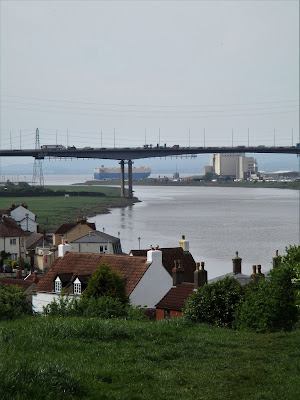 Son the Elder is acting at the moment, but Son the Younger and hairy, black-and-white Son decided to make good our promise to ourselves to walk it some time.
Son the Elder is acting at the moment, but Son the Younger and hairy, black-and-white Son decided to make good our promise to ourselves to walk it some time.We parked on Marine Parade, Pill, on the North Somerset bank of the River Avon, with views down to the motorway bridge at Avonmouth and upstream towards Horseshoe Bend.
 We started our walk by heading up Crockerne Pill, which is the name of the pill that gives Pill its name.
We started our walk by heading up Crockerne Pill, which is the name of the pill that gives Pill its name.Crockerne means pottery, which was made and shipped from here between 1100 to 1250AD.
Mainly, though, Pill made its living from the river.
It was home to the pilots who used to compete with each other to guide ships up and down the rocky, muddy, River Avon with its treacherous currents and huge tides. (This was before the docks relocated to Avonmouth.)
We ascended Watch House Hill, and reached Ham Green Lakes, which were landscaped in the 18th century as part of the eponymous estate.
A little further on, we regained the Avon.
This is the Old Powder House, which we also spotted on our Mother's Day walk. It was where ships' crews were obliged to offload gun powder and other inflammable materials before they reached the port in the centre of Bristol.
Up there, near the top of the cliff, is the layby on the Portway ...
... where these spliced-together photos were taken in March.
The curve of the bend delineated in vegetation
Every now and then we passed toadstools, which were once mooring posts, of course, and reminded me of the walk Ted (the dog) and I did some years ago with Dru Marland and John Terry, along the opposite bank from Sea Mills dock. There, too, were reminders of the river's history of shipping.
In fact, we'd walked nearly as far as Sea Mills, standing across the river on its own muddy pill, and it was time to retrace our steps.
A narrowboat pootled past.
And then a train, headed for Shirehampton, Avonmouth and maybe even the louche delights of Severn Beach.
 And then Bristol Packet's Bagheera, loaded with tourists on a sight-seeing trip.
And then Bristol Packet's Bagheera, loaded with tourists on a sight-seeing trip.It was a lot busier in the past.
Back at Ham Green Lakes, a gaggle of geese had taken to the water. Ted wisely ignored both them ...
... and this bruiser. What a Magnificat.
Our route took us past Ham Green House. Like Goldney House, Redland Court and Kings Weston House, it's another of those grand, Demerara-coloured houses in and around Bristol that are connected to the slave trade.
In 1899 it was bought by Bristol Corporation and turned into an isolation hospital. Two of my uncles were incarcerated there in the 1950s with TB.
And it too has a guard-cat.
From Watch House Hill there was a fine view of the M5 bridge and a large ship leaving Avonmouth Docks ...
... while back down in the village, the tide was now much higher than when we'd arrived.
The former Watch House of the Customs and Excise
And then it was time to leave lovely, not-quite-so-muddy Pill and head for home. Perhaps we'll walk more of the River Avon another afternoon.



























No comments:
Post a Comment